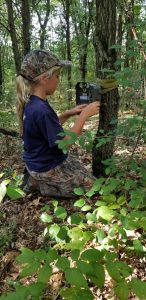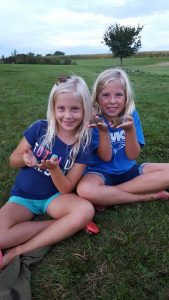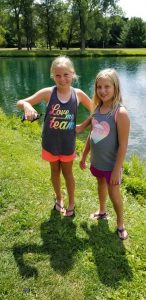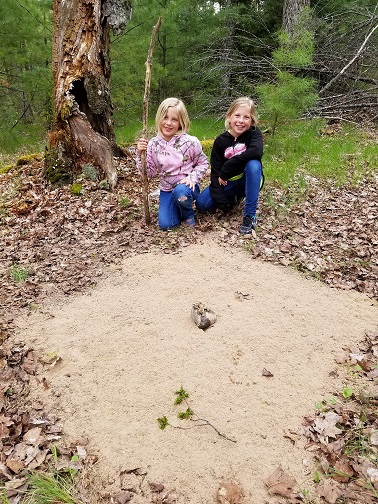Imagine my delight, when my daughters (9 and 11) complained about not being able to go outside during the polar vortex back in February. School had been cancelled due to the extreme cold and we were “stuck” at home and inside. My husband and I have made it a high priority to connect our children to the natural world, something that has served both of us well and led us to our careers in wildlife ecology & management. Early childhood experiences outdoors cemented our interests in natural resources and developed our conservation mindset. It is our hope, that repeated outdoor exposure, will do the same for our children.
Aside from our personal motivations, there is a wealth of research and literature describing a growing concern among parents, educators, and mental and physical health professionals throughout the country about the disconnection of today’s children from the natural world. “Nature Deficit Disorder” is a condition identified by author Richard Louv in his book “Last Child in the Woods” and has been linked to troubling childhood trends such as the rise in obesity, attention disorders and depression.
Letting kids play and explore in the natural world has proven psychological and cognitive benefits. When “we” were kids, our parents told us to go outside and play and didn’t expect us back until dinner time or dark. Today’s children often find their amusements, their adventures, in computer games and television. It’s no wonder children can grow up without knowing much at all about the natural world or its gifts. However, in some cases, they may even develop a fear of nature.
There are many benefits to children who spend time in nature and the outdoors, including reduced stress, an increase in curiosity, creativity and problem-solving abilities, and improved physical and emotional health.
The following is a list of ideas not only get kids outside, but to engage them in YOUR family property. Many of the ideas are wildlife-centric, of course!
- Every time your children and/or grandchildren visit, keep a list of the wildlife species you observe during their stay. How many different species of birds, mammals, reptiles and amphibians can you observe by sight, sound or animal sign? This simple activity has been a favorite tradition for my kids when they visit their grandparents.
- Encourage exploration and curiosity: turn over rocks and logs looking for invertebrates, salamanders, etc.; follow a set of animal tracks along a muddy riverbank; monitor a bird nest every few days to observe the process; or clean out last year’s bluebird and wood duck houses together and see what may have used it. My kids especially enjoy the excitement of catching a few deer mice when we clean out bluebird houses every spring!
- Go on a scavenger hunt: create a list of items ahead of time to look for and send the kids out to take photos of the items when they find them.
- Go Geocaching: an outdoor recreational activity, in which participants use a GPS unit or smart phone to hide and seek containers, called “geocaches” or “caches”. Download the geocaching app at: geocaching.com and head to the nearest natural area to start your search.
- Set-up a trail camera and check the media card when the children come for a visit. Scout the property with them and let them decide where to put it next.

- Have each of your children or grandchildren select a location for a photo station; a place where they take a photo periodically throughout the year to capture Wisconsin’s changing seasons.
- Give them a journal or sketchbook for them to record their observations. Journaling can be a great way for kids to decompress from their busy days and where better to do it than in nature. A nature journal is whatever you want it to be. Journaling includes elements of creative and descriptive writing, observation skills, art, and science. For children, it can be an excuse to go outside, to be alone, to expand artistic and writing skills, and to find the calm and the peace that quiet time in nature can promote.
- Participate in a citizen-science project together, such as the Wisconsin Frog & Toad survey (http://wiatri.net/Inventory/FrogToadSurvey/) or Cornell Lab of Ornithology’s Project Feeder Watch (https://feederwatch.org/).


- Embrace technology and let them show you how to use phone apps for bird identification (e.g. iBird Pro, Peterson Field Guide), plant identification (e.g. Leaf Snap), animal tracks (e.g. My Nature Tracks), viewing the night sky (e.g. Sky Map) and more.
- Build a couple of track stations on your property to document some of the more elusive, wide-ranging animals in the area. Clear a 1-meter square area of all vegetation using a shovel. Then add 5 gallons of fine, uniformly colored sand mixed with one cup of mineral oil. Masonry sand works well. Mineral oil helps to keep the sand moist and allows for a clear track print. Then, in the center of the station, place a large rock. The rock serves as a curiosity item for passing animals, but is also where you can place a teaspoon of lure. Try using a trapping lure that targets species like fox and coyote, bobcat, beaver, or an all-purpose lure. You can find lures, urines and baits at outdoor sporting goods stores or you can order them online from a trapping supplier. Then check your track station every morning or when you feel like it, to see who’s been visiting. Use a cat litter scoop or a sifter to reset the track station. Pairing a track station with a trail camera is a great way to confirm the identity of the visitor. You can also make plaster casts of the tracks for a souvenir (https://www.bear-tracker.com/plastertracks.html).
With spring finally upon us, now is the perfect time to get kids outdoors!
